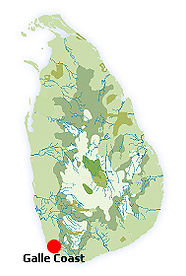GALLE FORT
Galle is a jewel. A Unesco World Heritage Site, this historic city is a delight to explore on foot, an endlessly exotic old trading port blessed with imposing Dutch-colonial buildings, ancient mosques and churches, grand mansions and museums. Wandering its rambling lanes you'll pass stylish cafes, quirky boutiques and impeccably restored hotels owned by local and foreign artists, writers, photographers and designers.
Built by the Dutch, beginning in 1663, Galle's core is the Fort, a walled enclave surrounded on three sides by the ocean. A key part of the Fort’s appeal is that it isn’t just a pretty place. Sure, tourism now dominates the local economy, but this unique city remains a working community: there are administrative offices and courts, export companies, schools and colleges.
Most travellers are utterly seduced by Galle's ambience, and it's undoubtedly southern Sri Lanka's one unmissable sight.

Galle Information and Google Map
PROVINCE : SOUTHERN PROVINCE
DISTRICT : GALLE DISTRICT
POPULAR : BEACH,FORT
WEATHER : 31 °C
PHOTO GALLERY
Historical Background
Galle has long been a hub of trade with ships from all parts of the world docking in its natural harbour to barter their goods. Galle is even referred to as the Biblical `Tarshish’ where King Solomon's ships called at port to take aboard treasures. The accidental arrival of the Portuguese Lorenzo De Almeida in 1505, when his fleet of ships steered off course following a storm, changed the history of this island nation. The Portuguese were followed by the Dutch in 1640 and then the British in 1796. Colombo became Sri Lanka’s main port in the 1870s and Galle’s influence waned, perhaps protecting its charm. The majority of Galle’s population is Sinhalese but there are significant communities of Moors, Malays, Tamils and scattering of Europeans, largely British, attracted by rich cultural heritage, beautiful beaches and laidback, artistic lifestyles.
Shopping
Galle Fort offers increasingly interesting shopping. Dutch period antique furniture and artefacts are available at the Olanda antique shop and the Historical Mansion. A small art and photographic gallery opens intermittently next to Galle Fort. The Elephant Walk sells local arts, crafts and food. Shoba Display Gallery makes art works and ornaments. The Barefoot Gallery has clothing and linen. Mimimango down Leyn Baan Street has a collection of ladies wear. Lollapalooza has clothing and gift items. The Corner Shop offers an eclectic mix of clothing, accessories and souvenirs. The Orchid House has linen clothing, silver jewellery and hand-made pottery.
Events
We are a huge admirer of the efforts that have gone into developing the Galle Literary Festival. The inaugural Festival in 2007 was immediately listed by Harpers Bazaar as one the six most appealing literary festivals, alongside such gatherings as the Hay Festival in Columbia and the Wexford Book Festival in Ireland. We applaud the efforts of the Galle Festival organizers in celebrating and encouraging Sri Lanka's literary heritage. This annual event is a treat for those interested in English literature, the creative arts and the cultural heritage of Sri Lanka.
Climate
Traditionally, the best time to visit the Galle coast is from mid-November to April, with similar weather patterns to the west coast. Between May and September, travel east beyond Galle along the south coast and more settled weather can often result. October can see heavy rain, although by November good weather is expected till May. Sri Lanka is affected by two monsoons which generally means that there is good weather somewhere. The main south-west (“yala”) monsoon brings rain to the west and south-west coasts and hills largely between May and July. The north-east (“maha”) monsoon hits the east coast predominantly from November to January. There is also an inter-monsoonal period of unsettled weather in October.
Sights
Galle Fort: This UNESCO World Heritage Site, originally built by the Portuguese and then further developed by the Dutch and the British, is one of Sri Lanka's most-loved areas. It covers nearly four sq kms, and is protected by 12 bastions and connecting ramparts. A maze of narrow roads lined with small houses and shops with Dutch names still remain. Recently, a spate of old colonial houses within the Fort have been intelligently renovated and made into exquisite boutique villas and hotels retaining the colonial architectural features including arches and columned courtyards, verandas, and high ceilings. A collection of arts and craft shops make this one of Sri Lanka's most vibrant quarters. Galle National Museum and Galle Maritime Museum are housed in the heart of the Fort.
Galle International Cricket Stadium: Galle Stadium is one of cricket's most-loved venues. The simple ground is flanked by the Indian Ocean and with the impressive 17C Galle Fort behind the bowlers at one end, you could barely imagine a more stunning environment in which to enjoy a cricket match. After the 2004 tsunami, it was thought that international cricket would never return to Galle. But thanks to the global cricket community, among them Shane Warne who took his 500th wicket at the ground, the ground has been restored.
Koggala Folk Museum: The late Martin Wickramasinghe, one of Sri Lanka’s most loved authors, grew up in the fishing village of Koggala. The Folk Museum that was the author’s dream was made a reality by the Martin Wickramasinge Trust and opened in 1981. Objects of folk culture acquired during his lifetime have been the starting point of the collection, which is growing annually.
Koggala Lake: scattered with 16 small islands, is a peaceful setting. Fish eagles to monitor lizards share this habitat along with generations of villagers. Boating, kayaking, canoeing in a traditional 'oru' and fishing and trolling on the lake are possible.
Yatagala Temple: Inland from Galle, this temple is built around and within giant boulder-like rock formations. Quiet and little visited, the temple looks out over paddy fields and small hamlets.











